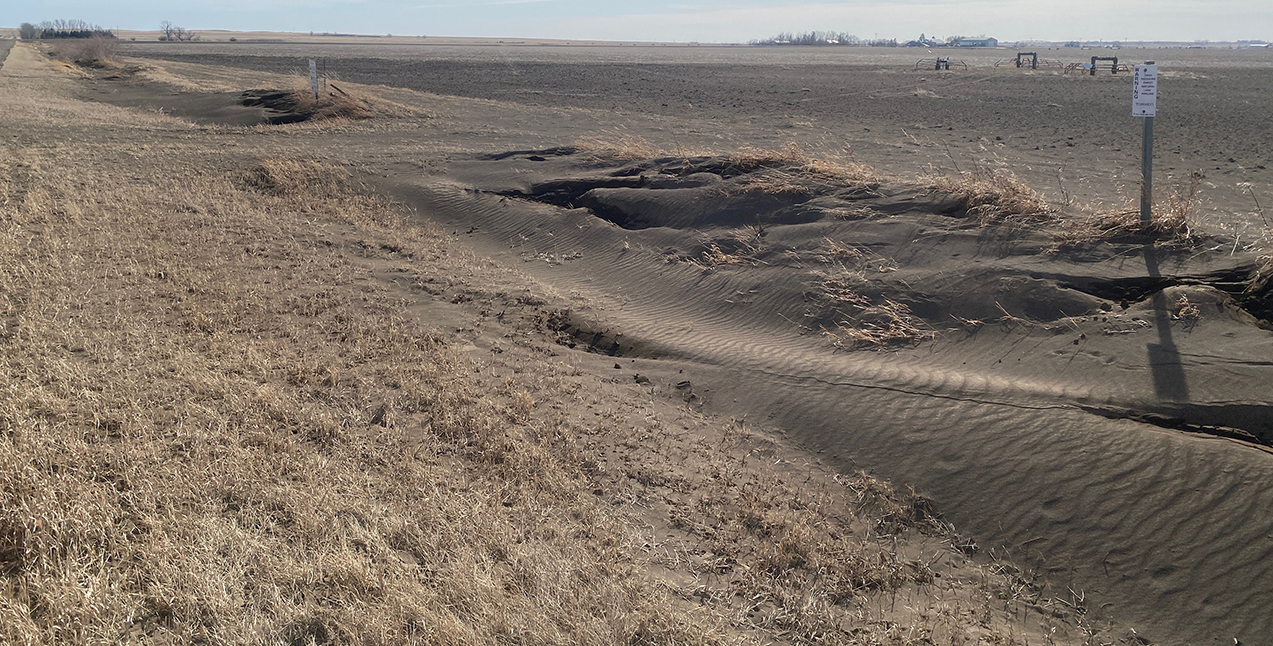
Soil Conservation became an important concern in the early 1930’s as wind erosion problems became more severe. Many people remember this as the “dirty thirties.” Through years of research, procedures and practices were recognized that we still use today. Such as re-establishing grass cover, extending crop rotations, winter cover crops, residue management, shelterbelts, conservation tillage and grassed waterways.
In 1935, “The Control of Soil Drifting Act” was passed. This confirmed the responsibility of the “occupier” of the land to control & prevent soil drifting. In 1962, this act was replaced by the Soil Conservation Act. With a few revisions throughout the years, the Soil Conservation Act is still what is used today to help prevent erosion and soil degradation.
The Soil Conservation Act’s main purpose is to provide a framework for farmers to encourage soil conservation practices. These practices are to preserve Alberta’s agricultural land base and to ensure the long-term productivity of the farming sector.
The main areas of concern under the Soil Conservation Act are wind erosion and water erosion. The risk of soil erosion through wind and water is increased when proper procedures and practices are not established and followed. Other forms of soil degradation that are destructive to soil quality are organic matter loss and salinization. View the MD of Taber Soil Conservation Policy.
Please note
Burning stubble on agricultural lands is prohibited without first notifying the Agricutlutral Fieldman and requesting permission. A Burn Permit will also be required.
Related links
| Questions? |
|---|
| Call 403-223-8735 Monday - Friday 8:00 am - 4:30 pm |
Water Erosion
Erosion is a natural process that often is enhanced by farming activities that leave the soil surface bare and susceptible to the forces of water. Erosion moves topsoil, reduces both the level of soil organic matter and available crop nutrients, and contributes to the breakdown of soil structure.
Although water erosion is a problem across the province it has received much less attention than wind erosion as it is not as visually impressive. Over time, physical changes are apparent in the form of eroded gullies and flooding.
Factors and farming practices that tend to lead to water erosion are:
- Cultivation of watercourses
- Cultivation of steep slopes
- Summer fallowing when it is not necessary for the conservation of soil moisture
- Cultivation of field slopes up and down, instead of with the contour
- Burying crop residue
Control options for reducing water erosion are:
- Conservation tillage techniques
- Reduced summer fallow
- Proper crop rotation
- Grass-covered watercourses
Related Links
Wind Erosion
 Erosion is a natural process that often is enhanced by farming activities that leave the soil surface bare and susceptible to the forces of wind. Erosion moves topsoil, reduces both the level of soil organic matter and available crop nutrients, and contributes to the breakdown of soil structure.
Erosion is a natural process that often is enhanced by farming activities that leave the soil surface bare and susceptible to the forces of wind. Erosion moves topsoil, reduces both the level of soil organic matter and available crop nutrients, and contributes to the breakdown of soil structure.
The risk of soil erosion by wind is extensive in Alberta where the climate is typically dry and large expanses of open fields are unprotected.
Factors and farming practices that tend to lead to wind erosion are:
- Sparse or absent vegetative cover
- Large fields
- Soil texture (sandy soils)
- High winds
Control options for reducing wind erosion are:
- Maintain a vegetative cover
- Reduce cultivated fallow
- Reduce or eliminate tillage
- Shelterbelts (farmstead & field shelterbelts)
- Avoid overgrazing
Related Links
Municipality's Responsibilities
The municipality has the following powers and responsibilities under the Soil Conservation Act:
- Power and responsibility to appoint at least one soil conservation officer for the municipality.
- Power to pass bylaws dealing with burning of stubble and removal of topsoil.
- Power to develop permits that prescribe the terms and conditions required for stubble burning and topsoil removal.
- Responsibility to set municipal policy by which the inspectors/officers should approach problems and identify problem areas.
- Responsibility to provide proper identification to the soil conservation officer.
- Responsibility to make provisions to hear appeals by aggrieved landowners.
Landwoner's Responsibilities
The role of the landowner and/or occupant is to protect the productivity of land through the prevention or minimization of soil erosion. The landowner and/or occupant has the following powers and responsibilities under the Soil Conservation Act:
- Power to appeal a notice.
- Right to refuse entry to buildings or structures at an unreasonable hour.
- Responsibility to prevent or minimize soil loss or deterioration from soil erosion.
- Responsibility to comply with notices given.
- Responsibility to pay for expenses incurred for carrying out remedial measures.
- Responsibility to allow inspectors to carry out their duties.
- Responsibility to hold valid permits and comply with the terms and conditions under which a permit is issued.
Shelterbelts
Shelterbelts help reduce the speed of wind which aids in the reduction of wind erosion. There are both farmstead shelterbelts and field shelterbelts.
Field shelterbelts should not be considered as an alternative to good residue management but as a complement. Field shelterbelts are a part of a conservation management system that will help protect the quality of the soils.
The Agricultural Services' Shelterbelt Program will help landowners plan, organize, order and plant shelterbelts. Costs are shared equally between the MD of Taber and the landowner, and Agricultural Services will help with planting and setting up drip irrigation if water is available nearby.
Related Links
Issuing a Soil Conservation Notice
If the remedial work is not been satisfactorily completed by the completion date indicated in the Letter of Concern, a Soil Conservation Notice will be issued at the discretion of the Manager of Agricultural Services in consultation with the Agricultural Service Board, and under the provisions outlined in the Soil Conservation Act.
